In early April, Stony Brook University School of Marine and Atmospheric Sciences's Christopher Gobler presented "State of the Bays 2023: Love Where You Live", a recording of which can be viewed above. Additionally, the article below summarizes much of what was discussed during the talk ... while also providing updates through the summer season.
Note: See "More Info" section below for a November '23 update on HABs in Long Island waterways.
— By Chris Gonzales, Freelance Science Writer, New York Sea Grant
Stony Brook, NY, August 28, 2023 - Scientists are learning more about the health risks caused by pollution in Long Island waterways. They’re also finding reasons for optimism.
Marine ecologist Christopher Gobler of Stony Brook University (SBU)’s School of Marine and Atmospheric Sciences (SoMAS) spoke earlier this year, delivering his annual “State of the Bays” address. In this talk, he highlighted water quality problems such as harmful algal blooms (HABs) and scientists’ efforts to improve conditions.
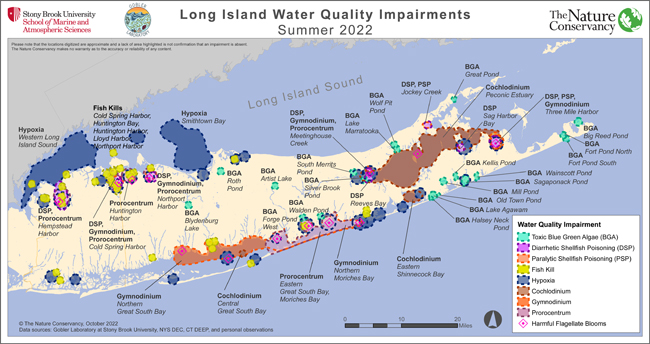
Long Island water quality impairments, summer 2022. Numerous types of HABs ringed the island in last year’s summer season. Credit: Christopher Gobler, SoMAS, Stony Brook University
“The warm winter has already spelled trouble,” Gobler said when I reached out to him in early May. “There are currently four shellfish bed closures across Long Island due to harmful algal blooms caused by Alexandrium contaminating shellfish with saxitoxin.”
Saxitoxin is a poisonous molecule one thousand times more potent than cyanide. It can be fatal to humans who have eaten contaminated shellfish. The Alexandrium dinoflagellate produces large quantities of the toxin during red tide events—when concentrations of the organism in the water are dangerously high.
Gobler traced this nitrogen-rich toxin back to Long Island’s delicate ecology and the overloading of nitrogen by humans into the soil and water.
“All of Long Island is a watershed,” Gobler said at the talk. “Water is at the soul of Long Island, and all activity on land affects the aquifer beneath our feet. All of these things are intimately connected.”
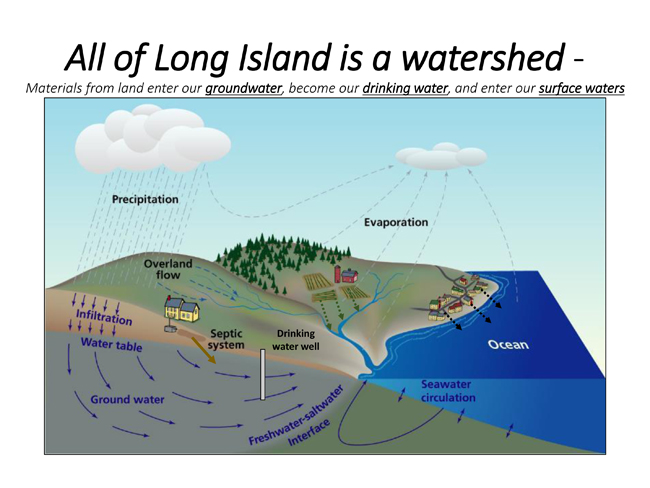
All of Long Island is a watershed. Materials from land enter our groundwater, become our drinking water, and enter our surface waters. Credit: Christopher Gobler, SBU SoMAS; Jack Cook/WHOI
He focused his talk specifically on nitrates and the sources of nitrogen in the water. Researchers detect on average around 4 mg/L of nitrate in Suffolk County groundwater samples. This is a very high level, putting the county in the top 5% of New York counties for the presence of nitrates in groundwater. Beyond drinking this water, it also finds its way out to sea.
An increasing number of recent studies are showing health risks associated with high levels of nitrate, including links to certain cancers.

Most nitrogen loading comes from wastewater. Credit: Christopher Gobler, SoMAS, Stony Brook University
“It's become a hot topic in scientific research,” Gobler said.
These findings include potential effects on babies during gestation, and links to birth defects.
Knowing this, he says, we need to keep nitrate levels in groundwater as low as possible.
In Suffolk County, 70% of homes are not connected to sewage treatment plants. Instead, they rely on household septic systems, which leach nitrogen into the groundwater. This is Long Island’s single largest source of nitrates entering the surface water.
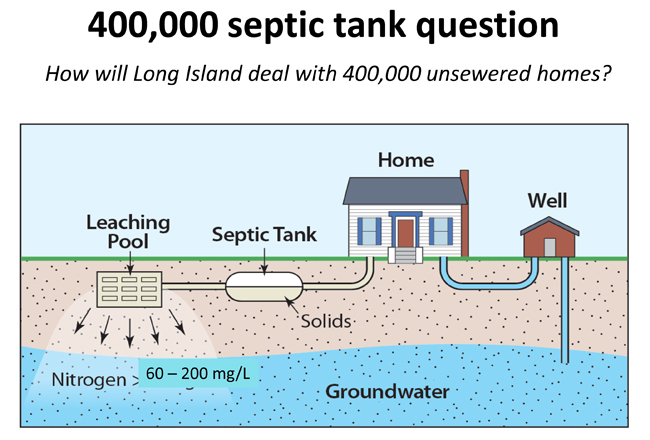
“How will Long Island deal with 400,000 unsewered homes?” Gobler asks. Credit: Christopher Gobler, SoMAS, Stony Brook University
Blue-Green Algae Blooms
Gobler also talked about blue-green algae, an organism that feeds off nitrogen, then releases a potent, nitrogen-rich toxin. These toxins wreak havoc on living things. Recent studies have found that the links are stronger than ever between the consumption of water with blue-green algae and certain gastrointestinal cancers. On the plains of Botswana, he mentioned, blooms of this cyanobacteria have been documented to kill elephants. This happens seasonally as ponds dry up and shrink, thus concentrating the algae and its toxins. Closer to home, a study from the Centers for Disease Control and Prevention (CDC) documents approximately 400 confirmed deaths of canines (dogs) each year from blue-green algae blooms, though the actual number is probably higher.
There have been more blue-green algae blooms in Suffolk County than in any other county in New York State. In comparison, in Nassau County, with a denser population, and where the majority of wastewater is treated through public sewer systems, they don't have such a high incidence of blue-green algae blooms.
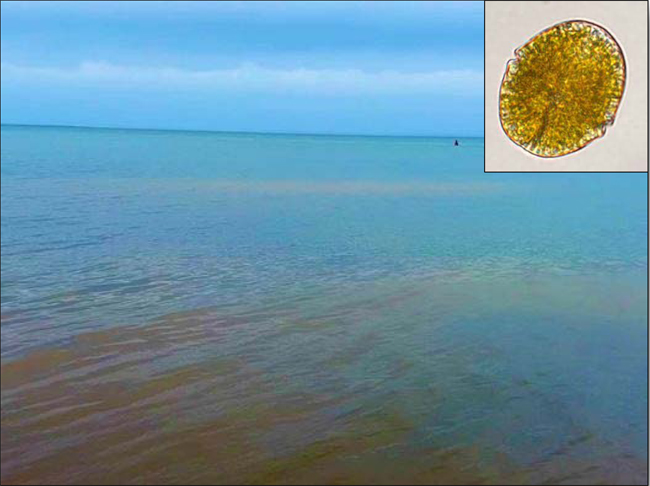
New Harmful Algal Blooms for New York? Gymnodinium. Credit: Christopher Gobler, SoMAS, Stony Brook University
Other Harmful Algae Blooms
Gobler’s team detected that several Gymnodinium blooms occurred in Great South Bay, Moriches Bay, and elsewhere in 2022. These have been associated with fish kills in the past, with one attracting much media attention in 2015. These algae damage fish gills, making it impossible for the fish to extract oxygen from the water.
Elsewhere, Dasysiphonia japonica continues to be a concern. The Gobler lab surveyed for Dasy throughout north and south shores, finding this macroalga has expanded to the north shore, as well as to the west, as far as Hempstead Bay.
Recent studies have shown Dasy to have lethal effects on larval fish.
Lack of Oxygen
The scientists looked at different coastal sites around Long Island, and with all of them, in samples taken during the night, oxygen levels dropped to levels below the recommended DEC threshold. The oxygen levels might look fine during the day when photosynthesis is happening. But from dusk to dawn, levels of the life-giving element sink.
Scientists know the overloading of nitrogen in the Long Island Sound causes declines of oxygen and intensifies algal blooms across Long Island.
A recent publication by Gobler’s PhD student Stephen Tomasetti shows how low oxygen and high temperature put stress on northern bay scallops1. Add in HABs, and these factors can be lethal to the scallops.
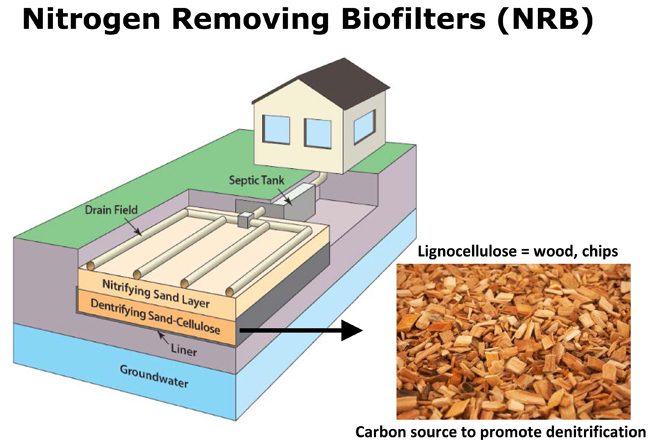
An advanced septic system uses wood chips to filter out excess nitrogen. Credit: Christopher Gobler, SoMAS, Stony Brook University
Alternative Septic Systems
Gobler discussed alternative septic systems than can remove most nitrogen from wastewater—before it enters the sea. Many grants are available to help homeowners install these systems.
Plus, overall, Gobler says, with reduced nitrogen loading in the Sound, overall, the water quality is getting better, with reduced occurrences of low-oxygen dead zones.
Even so, it may take years for groundwater to travel through the aquifer before it reaches the ocean.
Thus, in addition to alternative septic systems, Gobler said, we need in-water systems to keep the water clear.
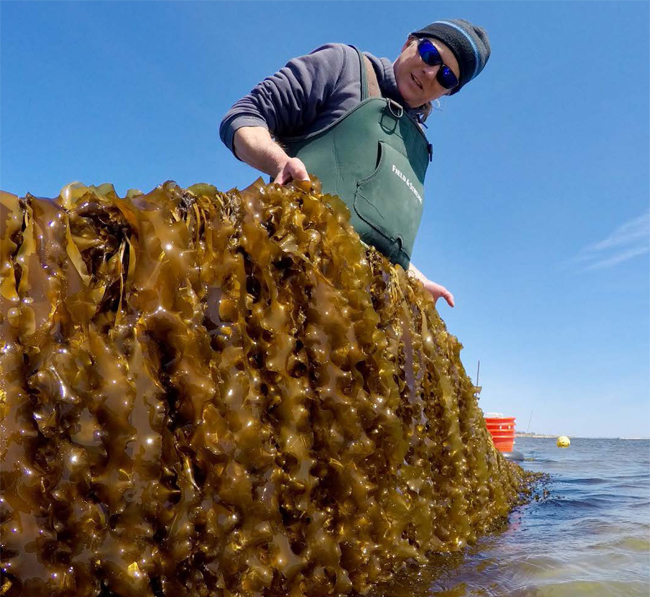
Sugar kelp (Saccharina latissima) can reduce ocean acidification on oyster farms. Credit: Christopher Gobler, SoMAS, Stony Brook University
Clam Sanctuaries and Kelp
Scientists are studying a potentially bright idea: “Hard clam spawner sanctuaries.” These are a natural way to clear the water of excess nutrients. Hard clams, being filter feeders, clear the water as they carry out their life processes. Researchers are finding ways to establish new colonies of hard clams and support existing ones.
Another idea for removing nitrogen from the water: kelp farms. Seaweeds can take up carbon dioxide and nitrogen, and provide oxygen. A one-acre kelp farm can remove 100-220 pounds of nitrogen in a year. Kelp can also reduce HABs, including dangerous ones that cause paralytic shellfish poisoning. While these are not a solution to the overall problem of global climate change, they’ve been shown to save bivalves from ocean acidification in lab experiments and on oyster farms.
Gobler recently completed a New York Sea Grant (NYSG)–funded project showing that Saccharina latissima, or sugar kelp, is highly effective at combating HABs on Long Island oyster farms. In addition, he has a NYSG project underway investigating the potential establishment of Gracilaria tikvahiae as a summer seaweed product for New York marine aquaculturists. Gracilaria is widely cultivated worldwide, providing a source of industrial agar, a food additive. It’s also used as a food product on its own and a fertilizer. It’s good at absorbing nutrients and improving water quality.
The range of solutions Gobler and his team proposes include septic system upgrades—a key part of Suffolk County’s Subwatersheds Wastewater Plan. Likewise, seaweeds like sugar kelp also offer hope. These aquatic plants work to take nitrogen and carbon dioxide out of the water.
Plus, Gobler points out, nitrogen reductions have already led to significant improvements in certain areas of Long Island.
“So far, things are OK,” Gobler said when I reached out to him again, in early August, to ask about current water quality in the Sound. “No hypoxia yet or fish kills, to my knowledge. There have been some HABs in Northport and Cold Spring Harbor.”
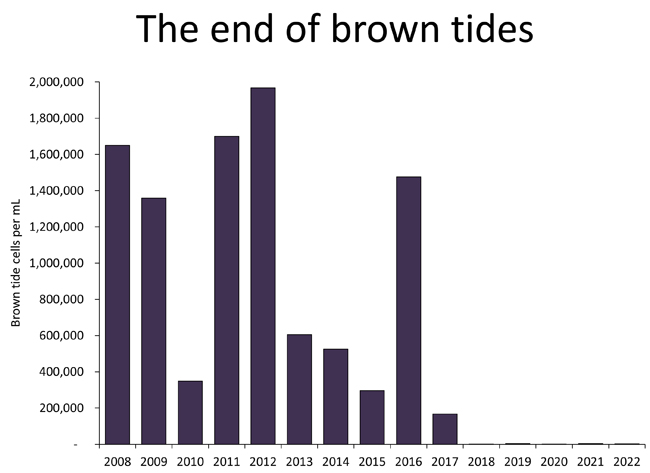
Brown tides have been virtually nonexistent for the last several years due to nitrogen control improvements. Credit: Christopher Gobler, SoMAS, Stony Brook University
HABs Reporting Tool
New York Sea Grant and Suffolk County Department of Health Services maintain a website that allows residents to report HABs they find in their area:
Suspicious Marine HAB reporting form
“The changing climate is having a pronounced impact on harmful algal blooms and there has been significant progress using satellite imagery to monitor these events,” said Antoinette Clemetson, New York Sea Grant’s marine fisheries specialist. “We are asking for assistance from stakeholders who use the coast —anglers, boaters, beach users, and others—to report suspicious algae by using the reporting tool so that managers can make better decisions when they collect these samples.”
This tool was created to help document HABs and inform the public of their occurrences."
References
1 Stephen J. Tomasetti, Brendan D. Hallina, Stephen T. Tettelbach, Nils Volkenborn, Owen W. Doherty, Bassem Allam, Christopher J. Gobler "Warming and hypoxia reduce the performance and survival of northern bay scallops (Argopecten irradians irradians) amid a fishery collapse" Global Change Biology November 2022 https://onlinelibrary.wiley.com/doi/10.1111/gcb.16575
More Info: On YouTube — Season of Discontent in Long Island's Coastal Waters back to top
A Stony Brook University report documents the worst algae blooms in LI waters on record. NewsdayTV's Steve Langford reports. Credit: Newsday/James Carbone, Steve Pfost; Photo Credit: Stony Brook University School of Marine and Atmospheric Sciences
— Information provided by Dr. Christopher Gobler
Patchogue, NY, November 2, 2023 - Scientists at Stony Brook University have completed their assessment of water quality in Long Island’s surface waters for 2023 and the news was not good –the announcement was made today at a press conference on the shores of Great South Bay. During the months of April through September, every major bay and estuary across Long Island was afflicted by harmful algal blooms (HABs), oxygen-starved, dead zones, and fish and turtles kills. Excessive delivery of nitrogen from onsite wastewater has been cited as the root cause of these disturbing events.
“Some aspects of 2023 were the ‘new normal’ for Long Island, but there were disturbing, unexpected outcomes as well” said Dr. Christopher Gobler, Professor of Stony Brook University. “This was the worst year for harmful algal blooms on Long Island, ever.”

New 2023 map shows record number of Harmful Algal Blooms and dead zones across Long Island. Credit: Chris Gobler
Gobler explained that there was a record-setting five shellfish bed closures in five locations covering thousands of acres across Long Island due to the occurrence of blooms of the saxitoxin-synthesizing alga, Alexandrium. Saxitoxin causes the human health syndrome, paralytic shellfish poisoning. These five closures in April and May were followed by an additional closure that began in May and extended into the summer that was caused by a bloom of Dinophysis in Moriches Bay that reached record densities. Dinophysis contains okadaic acid, a gastrointestinal toxin and the 2023 bloom was record-setting.
On the heels of these spring events came something new for Long Island, namely a HAB called Pseudo-nitzschia that contains a neurotoxin known as domoic acid that causes amnesic shellfish poisoning. The bloom covered south shore regions from Islip through Quogue across much of Great South Bay, all of Moriches Bay, and western Shinnecock Bay. Beyond detecting tens of millions of cells per liter, this bloom was also producing the toxin domoic acid, representing a new public health threat.
“This algal toxin has never been seen in Long Island waters and has had significant mortality effects on marine mammals on the west coast. Its high density in regions that had been previously flushed by the New Inlet that closed in 2023 suggests that, in addition to excessive nitrogen loads, poor flushing contributed to this event.”, said Gobler.
And the HABs did not stop there. In mid-July, a rust tide began on the east end of Long Island, starting in Shinnecock Bay and ultimately spreading through all of the Peconic Estuary. Rust tide is caused by the alga, Cochlodinum, that is ichthyotoxic, meaning it can kill fish and has been responsible for fish and shellfish kills on Long Island. The 2023 rust tide was the earliest start ever for a Rust Tide, and this was also the longest lasting rust tide as the event extended into early October. In 2012, the Gobler lab published an article in an international, peer-reviewed journal identifying the ability of excessive nitrogen to intensify these HABs, and in a 2019 publication, they identified the increase in summer water temperatures since the 20th century as a factor allowing these blooms to occur all summer in NY waters.
The HABs also extended inland in 2023 as there were more than two-dozen lakes and ponds that experienced outbreaks of blue-green algal blooms, a serious concern for both human and animal health. The south fork of Long Island was called out for hosting the ‘Dirty Baker’s Dozen’ as 13 water bodies in this region experienced these toxic blooms in 2023. For the past seven years, Suffolk County has had more lakes with blue-green algal blooms than any other of the 64 counties in New York State, a distinction that is likely to be repeated in 2023. Blue-green algae make toxins that can be harmful to humans and animals and have been linked to dog illnesses and dog deaths across the US and on Long Island.
The 2023 water quality impairment map also documented more than 30 distinct low oxygen ‘dead zones’ across the north shore, south shore, and east end of Long Island. All life in the ocean outside of some bacteria require oxygen to persist, a fact motivating the NYS Department of Environmental Conservation to strive for all water bodies at all times to have no less than 3 milligrams of dissolved oxygen. All 30 dead zones failed to meet this standard. While fish kills were not widespread in 2023, a lack of oxygen contributed to fish kills in locations on the south shore.
Over the years, the occurrence of harmful algal blooms and dead zones has contributed to the collapse of critical marine habitats such as seagrass, major fisheries on Long Island such as bay scallops and hard clams, and coastal wetlands that help protect waterfront communities from the damaging impacts of storms. Groups such as The Nature Conservancy have been working for more than a decade to revive and restore these habitats and shellfish but have been challenged by events such as those witnessed during the summer of 2023.
Excessive nitrogen coming from household sewage that seeps into groundwater and ultimately, into bays, harbors, and estuaries or, in some cases, is directly discharged into surface waters, is a root cause of the maladies of 2023. Excessive nitrogen stimulates algal blooms that can, in turn, remove oxygen from bottom waters as they decay. Suffolk County and Nassau County recently completed ‘subwatershed studies’ that identified wastewater as the largest source of nitrogen to surface waters and set goals for reducing nitrogen loading from septic systems as a defense against these impairments.
Despite the gloomy news, there were some signs of hope in the data.
“In Long Island Sound, the western dead zone in 2023 was significantly smaller than it was 20 years ago thanks to sewage treatment plants removing 60% more nitrogen and reducing the flow of nitrogen into the western Sound”, said Gobler. “This proves that reductions in nitrogen loading does improve water quality.”
Counterbalancing this high note was the growth of a second dead zone in central Long Island Sound emanating from Smithtown Bay suggesting this region now needs significant reduction in nitrogen loading.
The report on the summer of 2023 was compiled by the Gobler Laboratory of Stony Brook University that has been monitoring and sampling Long Island’s waters on a weekly basis every summer since 2014. Data was also generated by the Long Island Sound Study which is funded by the US Environmental Protection Agency. The data was reported weekly on News 12 and Newsday as part of their weekly Water Quality Index.
More Info: New York Sea Grant
New York Sea Grant (NYSG), a cooperative program of Cornell University
and the State University of New York (SUNY), is one of 34 university-based
programs under the National Oceanic and Atmospheric Administration’s
National Sea Grant College Program.
Since 1971, NYSG has represented a statewide network of integrated
research, education and extension services promoting coastal community
economic vitality, environmental sustainability and citizen awareness
and understanding about the State’s marine and Great Lakes resources.
Through NYSG’s efforts, the combined talents of university scientists
and extension specialists help develop and transfer science-based
information to many coastal user groups—businesses and industries,
federal, state and local government decision-makers and agency managers,
educators, the media and the interested public.
The program maintains Great Lakes offices at Cornell University, SUNY
Buffalo, SUNY Oswego and the Wayne County Cooperative Extension office
in Newark. In the State's marine waters, NYSG has offices at Stony Brook
University and with Cornell Cooperative Extension of Nassau County on Long Island, Brooklyn College and Cornell Cooperative
Extension in NYC and Kingston in the Hudson Valley.
For updates on Sea Grant activities: www.nyseagrant.org has RSS, Facebook, Twitter, Instagram, and YouTube links. NYSG offers a free e-list sign up via www.nyseagrant.org/nycoastlines for its flagship publication, NY Coastlines/Currents, which is published quarterly.